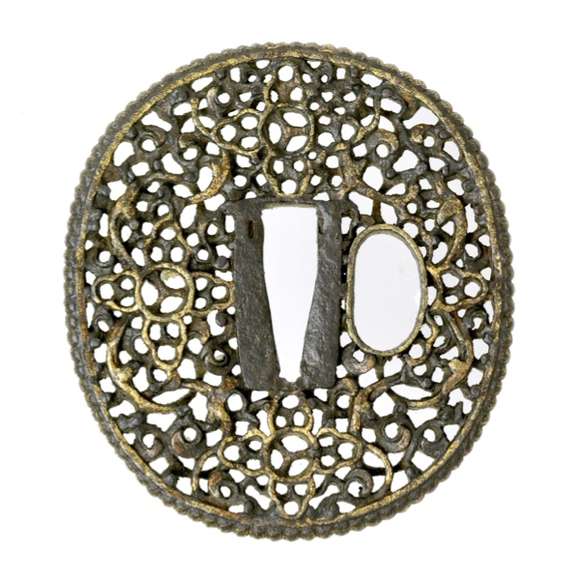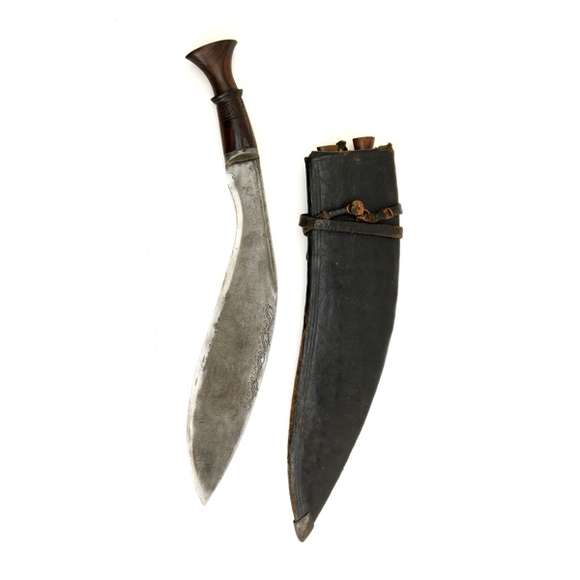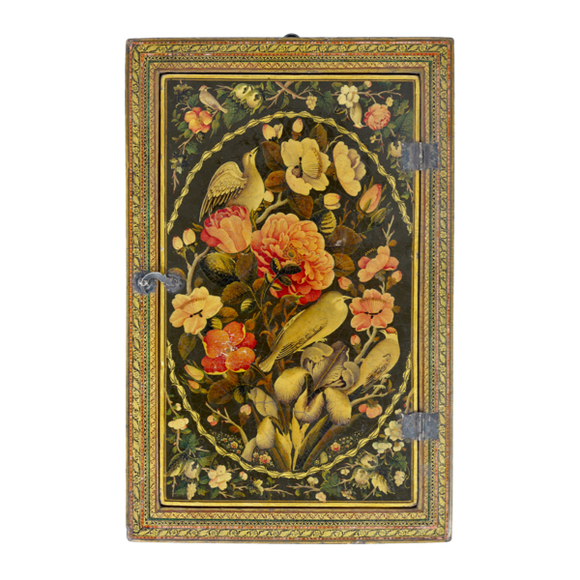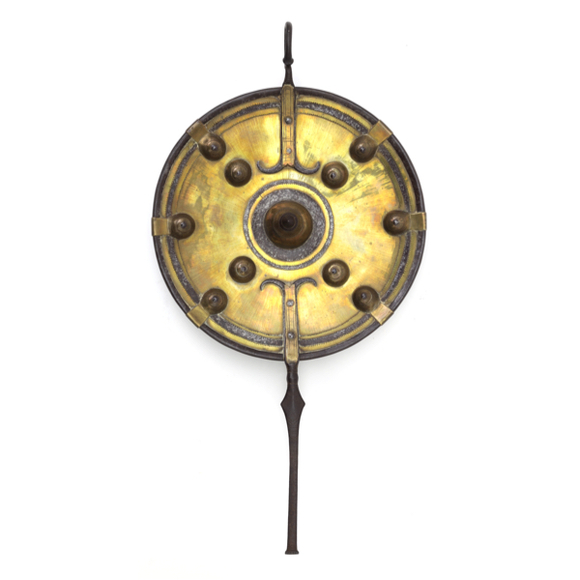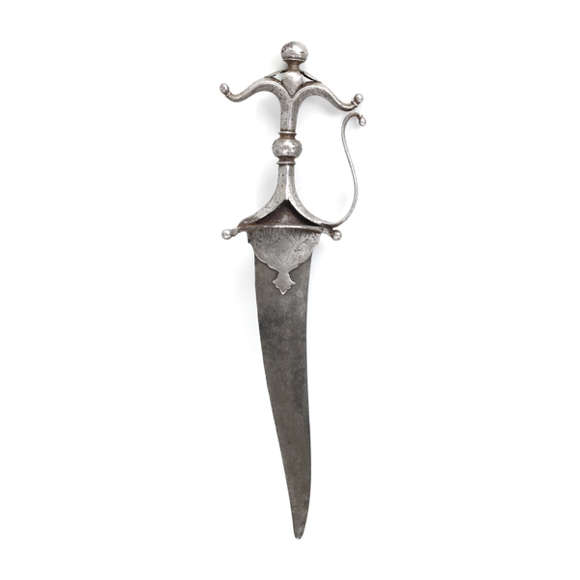Language: Persian
Source: Period writings and dictionaries
Description
Koft-garī (کوفت گری) is the Persian word for the inlay and overlay of gold or silver on iron or steel.1 As a Persian loan word it was widely used from the Ottoman Empire to north India.
It was also called simply koft (کوفت). It consists of the words: koft (کوفت); Interwoven; a blow, bruise, and garī (گری); practice, trade. The person who does the work is called the koftgar (کوفت گر).2
The original meaning meant to describe any kind of inlay or overlay but among collectors today, koftgarī is almost exclusively used for a type of overlay over a crosshatched background. The true inlay is known as tah-nishān (ته نشان) where tah means "to fold" and nishān "to mark".
Notes
1. Francis Joseph Steingass; A comprehensive Persian-English dictionary, including the Arabic words and phrases to be met with in Persian literature. London: Routledge & K. Paul, 1892.
2. Thomas Holbein Hendley, C.I.E.; Damascening On Steel or Iron, as practised in India. W. Griggs & Sons, Ltd. London 1892.
Types of work
Two main types of koftgarī can be distinguished:
1. "True inlay" or tah-i-nishan
The gold or silver is beaten into channels. It can be polished flush with the surface or made to stand out a little, in which case it was called zar-i-nishan. Both methods are very durable but also very labor-intensive. On antique arms of India, true inlay is rare and highly prized by collectors.2
2. "Overlay" where the gold or silver is applied on a crosshatched surface. When new and well done it may look similar to zar-i-nishan but it is far less durable. When the gold wears down it will reveal the cross-hatching underneath. On antique arms, this is the most commonly found method.
Centers of production
Although similar work done on bronze can be traced to ancient Egypt, the work as we know it today is generally believed to have originated in Persia and was spread to India through the Timurids, into the Punjab and later also in Rajputana.1
By the late 19th century, known centers of production were Kashmir, Gujarat, Sialkot in the Punjab, Multan, Lucknow, Jaipur, Alwar and Hyderabad.2
In the early 20th century, most production seems to have stopped with the exception of Sialkot.3
Notes
1. Thomas Holbein Hendley, C.I.E.; Damascening On Steel or Iron, as practised in India. W. Griggs & Sons, Ltd. London 1892.
2. Official catalogue of the Empire of India exhibition: Earl's Court, London, S.W. Printed and published by J.J. Keliher & Co., London. 1895. Pages 214-215.
3. Monograph on Iron and Steel Industries in the Punjab 1906-07. Lahore, 1908. Page 6-7.
In period sources
Unfortunately, this branch of the trade covers a very small field. In fact art in iron and steel work is scarcely to be found in the Punjab, except in the "Koft" or damascene work of Kotli Loharan, in the Sialkote district, and of Gujrat. This consists of the inlaying of gold and silver wire on steel or iron. For a general description of the work I think I cannot do better than quote Mr. Percy Brown, Principal of the Mayo School of Art, on the subject.
“The art is a very ancient one, but the name was invented by the crusaders who brought wonderful specimens of it with them from Damascus. It is interesting to note that no damascening is done in that city at the present time, the art having been extinguished when Damascus was conquered by
Timur in 1401. This monarch conveyed many of the best specimens of the metal worker’s art into Persia, and there is little doubt that during his victorious entry into India this art was introduced. Sialkote in the Punjab was probably the first place in which damascening was practised, and although it is carried on very successfully in various other places Such as Jeypore, Daria in Central India, Serohi, Jodhpur and Alwar, it is believed that the art of these localities originally came from the Punjab.
“The damascening of India is of various qualities according to the different methods employed. The most valuable and truest form of the art is known as “ Teh-nishan,” from two Persian words which signify a plait or fold, and a mark or scar, thus indicating the origin of the art as far as India is concerned, as well as the mode of practising it. In this the pattern is first deeply engraved in the steel, and gold or silver wire hammered into the grooves.
The surface is then filed, polished and blued.
"When both gold and silver wires are used the combination is called ‘ Ganga-Jarani,’ to signify the confluence of the two great rivers of Northern India.
“Another and cheaper form of this craft is to "cross-hatch" the surface of the metal all over, so that it has a rough texture like a fine file. The pattern is lightly incised on this with a sharp steel style and then the finest of gold wire is pressed on to the lines with an agate burnisher. The article is next polished and “blued,” and if carefully executed can easily be mistaken by the uninitiated for the better class of work. Most of the modern work is done in
this way. There are several variations of this method, in some of which gold leaf is applied as well as the wire to the roughened surface, giving the
appearance of greater richness and a more lavish use of the precious metal”.
At the present time, there is little or no damascening at Gujrat, but there is one factory at Sialkote with six workmen engaged in koftgari. The art probably originated in the ornamentation of arms, swords, daggers, etc., and appears to have been practised extensively up to the end of the Sikh rule. After that period, when owing to the Disarmament Act there was little or no demand for swords and the like, the workmen had to look for other articles on which to show their skill. The result now is that they have been compelled to copy various small articles of European origin. The work has suffered accordingly, and instead of using the old method of incised and deeply laid damascene the artists are content to simply scratch the pattern on the steel and iron, and hammer in a very fine gold wire pressing it down with an agate point.
This is the cheaper method referred to by Mr. Brown and it is unfortunately the one which is almost universally practised now-a-days. If the metal
articles on which “koft” is now worked were of any real practical value, there would be some chance of the art regaining its former prominence. As it is,
were it not for the tourist and the curio collector it would in all probability cease to exist. The work requires time, skill and patience and the profits are not large, hence the skilled workmen prefer to take employment in large factories and workshops, finding that they can thereby obtain a greater reward for their labours.
I now give a more detailed description of the process of manufacture, showing the names of the different implements. The iron or steel ground on which the wire is to be inlaid is smoothed with a file (rawati), and then polished with a pumice stone (tchingra). The pattern is then incised with a steel pen, after which the article is heated in a clear fire for a few minutes and blued. The gold wire to be inlaid is also heated and softened. The wire is then placed into the lines with an iron pencil (pathrani), it is then hammered and rubbed with an agate point (mohari). If it is necessary to cut the wire at all scissors (hath) are used, but in the modern work generally short lengths of wire are employed."
https://archive.org/stream/dli.granth.106526/106526_djvu.txt
Description of Sirohi & Tanjore work
https://archive.org/details/indianartatdelhi00indi/page/n69/mode/2up?q=koftgari
1888 source
https://archive.org/details/artmanufactureso00mukh/page/178/mode/2up?q=koftgari
Notes
1. Sir George Watt; Indian art at Delhi, 1903. Being the official catalogue of the Delhi exhibition, 1902-1903. Indian Art Exhibition, Delhi, 1903.
2. Trailokya Nath Mukharji; Art manufactures of India, specially compiled for the Glasgow International Exhibition, 1888. Superintendent of government printing, Calcutta, India, 1888.

